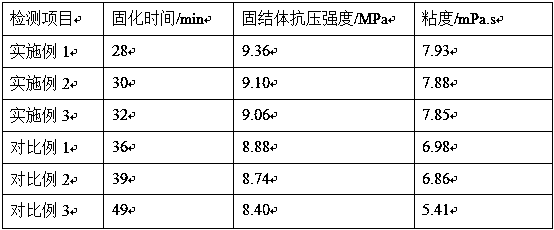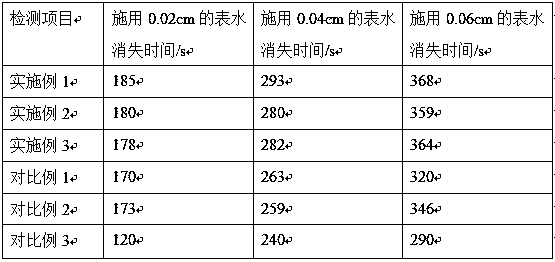Polymer sand-fixation agent
A technology of sand-fixing agent and polymer, applied in the field of sand-fixing, which can solve the problems of poor film-forming property, poor water-retaining effect, and not easy to loose sand and agglomerate, and achieve the effects of improving swelling rate, improving water-retaining effect, and strengthening sand-fixing effect
- Summary
- Abstract
- Description
- Claims
- Application Information
AI Technical Summary
Problems solved by technology
Method used
Image
Examples
preparation example Construction
[0032]The preparation method of composite polymer emulsion, comprises the steps:
[0033] (1) Mix 2-amino-4-hydroxy-6-methylpyrimidine and dimethyl sulfoxide in a mortar according to the mass ratio of 7~12:1, and grind at 350~550r / min for 1~3h to obtain the abrasive , take the grinding material and heat-treat it in an oven at 45~65°C for 12~16h to obtain a dry material, take the dry material in a reaction kettle, add hexamethylene diisocyanate with a weight of 8~13% of the dry material to mix, and protect it with nitrogen, and use 400~ 700r / min magnetic stirring for 30~55min, heating up to 60~80°C, cooling down to room temperature naturally to obtain the reaction material, taking the reaction material and adding n-hexane to mix at a mass ratio of 1:3~5, stirring at 500~800r / min for 2~ 4h, get the functional monomer liquid;
[0034] (2) At 30~55°C, take acrylic acid, butyl acrylate, functional monomer liquid, and NaOH solution with a mass fraction of 10~15% according to the ma...
Embodiment 1
[0040] Additive: Mix didecyl sebacate and sodium laureth sulfate at a mass ratio of 3:1 to obtain the additive.
[0041] Initiator: Mix sodium persulfate and azobisisobutyronitrile at a mass ratio of 2:1 to obtain an initiator.
[0042] Rubber material: Mix guar gum and xanthan gum at a mass ratio of 2:1 to obtain the rubber material.
[0043] Reagent A: Mix a 60% triethylamine solution and a 0.1mol / L sodium carbonate solution at a mass ratio of 4:1 to obtain Reagent A.
[0044] Reagent B: Mix calcium chloride solution with a concentration of 0.2 mol / L and glutaraldehyde at a mass ratio of 7:1 to obtain reagent B.
[0045] Auxiliary agent: Mix azobenzene, cyclodextrin, and mercaptoethanol in a mass ratio of 1:3:2 to obtain an auxiliary agent.
[0046] Film-forming agent: in parts by weight, 20 parts of N-methylpyrrolidone, 10 parts of graphene oxide, 6 parts of nitrocellulose with a nitrogen content of 11.2%, 8 parts of 4,4'-dinitrodiphenyl Disemicarbazide was mixed in the ...
Embodiment 2
[0055] Additive: Mix didecyl sebacate and sodium laureth sulfate at a mass ratio of 6:1 to obtain the additive.
[0056] Initiator: Mix sodium persulfate and azobisisobutyronitrile at a mass ratio of 4:1 to obtain an initiator.
[0057] Rubber material: Mix guar gum and xanthan gum at a mass ratio of 5:1 to obtain the rubber material.
[0058] Reagent A: According to the mass ratio of 8:1, take 60% triethylamine solution and 0.1mol / L sodium carbonate solution and mix to obtain reagent A.
[0059] Reagent B: Mix calcium chloride solution with a concentration of 0.2 mol / L and glutaraldehyde at a mass ratio of 10:1 to obtain reagent B.
[0060] Auxiliary: Mix azobenzene, cyclodextrin, and mercaptoethanol at a mass ratio of 1:6:2 to obtain an auxiliary.
[0061] Film-forming agent: in parts by weight, 35 parts of N-methylpyrrolidone, 18 parts of graphene oxide, 10 parts of nitrocellulose with a nitrogen content of 12.5%, 14 parts of 4,4'-dinitrodiphenyl Disemicarbazide was mixe...
PUM
 Login to View More
Login to View More Abstract
Description
Claims
Application Information
 Login to View More
Login to View More - Generate Ideas
- Intellectual Property
- Life Sciences
- Materials
- Tech Scout
- Unparalleled Data Quality
- Higher Quality Content
- 60% Fewer Hallucinations
Browse by: Latest US Patents, China's latest patents, Technical Efficacy Thesaurus, Application Domain, Technology Topic, Popular Technical Reports.
© 2025 PatSnap. All rights reserved.Legal|Privacy policy|Modern Slavery Act Transparency Statement|Sitemap|About US| Contact US: help@patsnap.com


